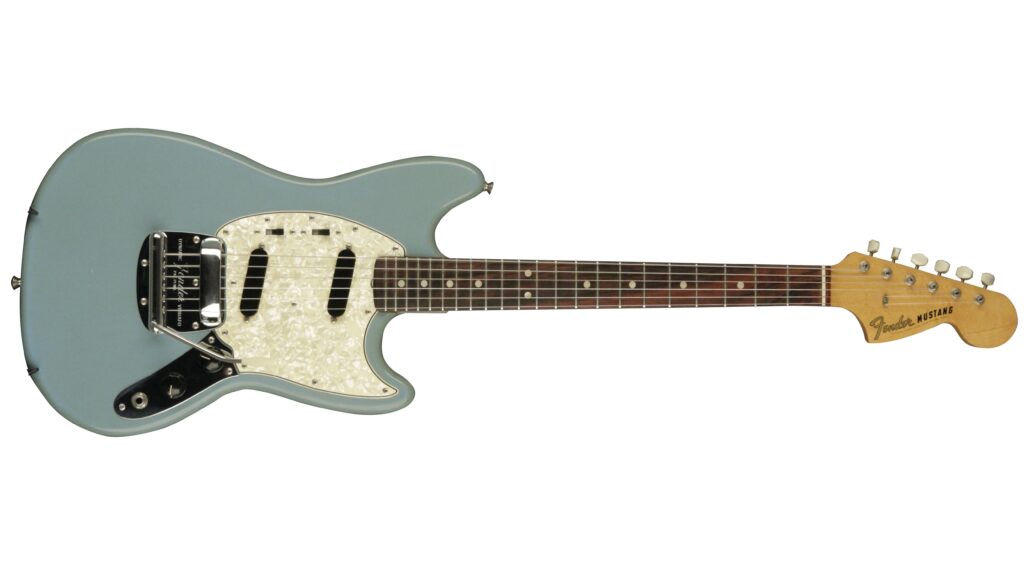Rediscovering the Vintage Fender Mustang: A Journey Through Time and Sound
In the realm of electric guitars, few instruments evoke the charm and character of the vintage Fender Mustang. Born in the vibrant era of the 1960s, this iconic model emerged as a symbol of youthful rebellion and innovation, captivating aspiring musicians and seasoned artists alike. With its distinctive offset body, unique tonal palette, and a rich history intertwined with some of rock and roll’s most legendary figures, the Mustang is not just a guitar—it’s a testament to creativity and the evolution of music. This article invites you to embark on a journey exploring the allure of the vintage Fender Mustang, examining its origins, design intricacies, and the cultural impact that continues to resonate with players across generations. Whether you’re a seasoned guitarist, a collector, or simply a fan of musical history, there’s much to uncover about this timeless instrument and the magic it brings to the stage.
Exploring the Iconic Design Heritage of the Vintage Fender Mustang
The Fender Mustang, with its vivid history and distinctive silhouette, has become a lasting symbol of both artistry and innovation in the world of electric guitars. Introduced in 1964, the Mustang was originally designed as a student model, yet its quirky design and unique tonal properties quickly captured the hearts of musicians across genres. The body, shaped like an offset, offers not only a striking aesthetic but also an ergonomic advantage, making it comfortable to play for extended sessions. Consider the essential features that contribute to its iconic status:
- Short Scale Neck: This design allows for easier playability, particularly suited for novices and those seeking a less demanding fretboard experience.
- Unique Pickup Configuration: The Mustang’s single-coil pickups deliver a jangly, bright tone that stands out in both clean and distorted settings.
- Vibrato Tailpiece: Offering expressive whammy bar functionalities, it enhances its versatility for musical experimentation.
Over the decades, the Mustang has been embraced by a diverse array of artists, from punk rockers to alt-rock legends, further solidifying its place in music history. Fender’s ability to maintain the original aesthetics while also introducing modernized versions ensures that the Mustang continues to resonate with both vintage enthusiasts and new players alike. Here’s a concise comparison showcasing key models through the years:Candy Land VintageVintage Infant Of Prague Statue
| Model | Year Introduced | Notable Features |
|---|---|---|
| Fender Mustang | 1964 | Short scale, offset body |
| Fender Mustang Competition | 1970 | Distinctive graphic finishes |
| Fender Mustang Bass | 1975 | Bass variant with similar aesthetics |
A Deep Dive into Sound: The Unique Tone of Mustang Pickups
The sound of a Fender Mustang is an experience that resonates with musicians on multiple levels, largely due to its unique pickup configuration. At the heart of its charm are the Mustang single-coil pickups, designed to deliver a bright, clear tone that splashes across a variety of music genres. These pickups, characterized by their distinct shape and winding style, create a sound profile that is often described as both edgy and articulate. Here’s what sets them apart:
- Dynamic Response: Mustang pickups respond dynamically to playing style, allowing for both soft nuances and bold riffs to shine through.
- Vintage Character: Their vintage construction lends a warm, classic vibe that appeals to retro enthusiasts.
- Focused Midrange: These pickups excel in the midrange frequencies, making them ideal for cutting through mixes in band settings.
The tonal qualities of Mustang pickups are not just theoretical; musicians have documented their experiences with these jewels. Below is a simple comparison table highlighting some key tonal aspects:
| Tonal Characteristic | Description |
|---|---|
| Brightness | Sparkling highs that add clarity. |
| Warmth | Rich, buttery tones perfect for blues and rock. |
| Dynamic Range | Versatile response across different playing styles. |
With such a distinctive tonal palette, it’s no wonder the Mustang has carved out a special place in the hearts of guitarists. The interplay between the instrument’s build and its pickups creates a magical synergy, inviting players to explore the nuances of their craft with unmatched dexterity and expression.
Restoration and Maintenance Tips for Vintage Mustang Owners
Maintaining the iconic charm of your Vintage Fender Mustang requires a delicate balance of care and expertise. To keep your instrument in top shape, consider these essential strategies: Regular Cleaning – Use a soft, lint-free cloth to wipe down the guitar after each session, preventing the buildup of dirt and oils. String Maintenance - Change your strings regularly, as old strings can affect tone and playability. Opt for high-quality strings that suit your playing style and climate. Temperature Control – Store your Mustang in a stable environment, avoiding extreme temperatures and humidity that can damage the wood and electronics. This simple practice can prolong the life of your instrument and preserve its beautiful finish.
When it comes to repairs and upgrades, it’s wise to approach them with caution. If you find yourself needing to replace components, making note of the original parts can help you maintain authenticity. Consider these vital tips: Use OEM Parts - Whenever possible, source original equipment manufacturer parts to keep the Vintage Fender Mustang true to its heritage. Consult Professionals – Working with a luthier who specializes in vintage guitars can ensure proper handling and repairs. Document Modifications – Keeping a log of any repairs or modifications not only helps you remember what changes have been made but can also be beneficial for future buyers or collectors.
Modern Modifications: Enhancing Your Vintage Fender Mustang
Transforming your vintage Fender Mustang can be a thrilling journey that balances nostalgia with modernity. Begin with upgraded pickups, as these will significantly enhance your tone while preserving the character of the guitar. Options like humbuckers, which offer a thicker sound, or single-coil replacements designed for clarity, can breathe new life into your instrument. Other suggestions include the addition of a new bridge for improved sustain and tuning stability, or even a vibrant custom pickguard to reflect your personal style. Here’s a quick overview of some popular modification choices:
- Pickups: Alnico V, P90, or Custom Strat pickups
- Bridge: Mustang style, hardtail, or floating tremolo
- Pickguard: Tortoise shell, mirror, or custom art designs
Next, consider upgrading the electronics to refine your control over tone and volume. A quality set of potentiometers paired with a capacitor upgrade can significantly change the responsiveness of your Mustang. For those looking for cutting-edge features, adding a coil-split switch provides versatility by allowing single-coil tones from humbuckers. The following table illustrates potential electronic upgrades:
| Upgrade | Benefit |
|---|---|
| High-Quality Potentiometers | Smoother Knob Action |
| Capacitor Upgrade | Enhanced Tone Clarity |
| Coil-Split Switch | Additional Sound Versatility |
Fender Mustang in Popular Culture: A Journey Through Music History
The Fender Mustang has carved out a unique niche within the realm of popular music, celebrated for its distinctive sound and playful aesthetic. Originally launched in 1964, this guitar resonated with a younger audience, especially students and budding musicians, due to its affordability and sleek design. Over the decades, the Mustang has been embraced by major artists and genres, from the gritty soundscapes of punk rock to the ethereal tones of shoegaze. Some notable musicians who have wielded the Mustang include:
- Kurt Cobain – The iconic frontman of Nirvana popularized the Mustang in the alternative rock scene.
- John Frusciante – Red Hot Chili Peppers’ guitarist used it extensively during his creative peak.
- Jeff Buckley – Known for his emotive playing, Buckley’s Mustang contributed to his uniquely haunting sound.
These musical legends have helped the Mustang transcend its humble beginnings, making it a desirable vintage piece. Its simple controls and short scale length allow for a playfulness that appeals to a wide range of guitarists. Moreover, the Mustang’s signature offset body shape and vibrant color options have made it a favorite among collectors and fashion-conscious musicians alike. In fact, the following table highlights some key variants that have reflected different eras in music history:
| Model | Year Introduced | Notable Feature |
|---|---|---|
| Mustang I | 1964 | Original model with a simplistic design |
| Mustang Kurt Cobain | 1990s | Signature model with unique pickups |
| Mystic Seafoam Mustang | 2020 | Limited edition with a striking color |
Finding the Right Vintage Mustang: Tips for Collectors and Enthusiasts
When embarking on the journey to find the ideal vintage Fender Mustang, it’s essential to educate yourself about the various iterations and nuances of this iconic guitar. Start by familiarizing yourself with the different production years, as certain models feature unique characteristics that appeal to collectors. Key factors to consider include:
- Year of Production: Different years saw changes in body shape, pickup types, and finishes.
- Condition: Look for originality in parts and signs of wear that may enhance the guitar’s character.
- Color and Finish: Original colors can elevate resale value, while rare finishes are particularly sought after.
Once you’ve honed in on your preferences, it’s time to explore where to find these vintage gems. Engaging with reputable dealers and attending guitar shows can provide access to well-preserved instruments. Furthermore, networking with fellow collectors may lead to insider opportunities. Consider keeping a checklist to streamline your searches, focusing on:
| Criteria | Description |
|---|---|
| Sound Quality | Test the guitar to ensure it resonates well with your musical style. |
| Documentation | Seek models with original cases, manuals, or receipts for authenticity. |
| Price Range | Establish a budget while remaining flexible for unique finds. |
Q&A
Q&A: Exploring the Vintage Fender Mustang
Q: What is the Fender Mustang, and what makes it a vintage instrument?
A: The Fender Mustang is a solid-body electric guitar that was originally introduced in 1964. It’s recognized as a vintage instrument due to its classic design, unique features, and the nostalgic value it holds among musicians and collectors alike. Models from the 1960s through the early 1970s, especially those with original components and finishes, are considered vintage.
Q: What are some distinguishing features of the vintage Fender Mustang?
A: The vintage Mustang is characterized by its offset body shape, which offers a comfortable playing experience, especially for standing musicians. It typically comes with two single-coil pickups, a shorter 24-inch scale length, and unique controls that include a 3-way pickup selector and a rhythm/lead circuit. Its distinctive design and bright aesthetics, often seen in vibrant colors like Sonic Blue and Fiesta Red, also contribute to its vintage charm.
Q: Who were some of the notable musicians associated with vintage Fender Mustangs?
A: The Fender Mustang has been embraced by many influential musicians throughout history, particularly those in the alternative and punk rock scenes. Notable players include Kurt Cobain of Nirvana, who famously used a Mustang during the band’s rise in the 1990s, and indie rock icon J Mascis of Dinosaur Jr. Additionally, artists like Robert Smith of The Cure and even the late Jimi Hendrix have been linked to this uniquely styled guitar.
Q: How does the sound of a vintage Mustang compare to other Fender models?
A: The vintage Mustang typically produces a bright, twangy tone that sets it apart from other Fender models like the Stratocaster or Telecaster. Its shorter scale length contributes to a warmer, less aggressive sound, with the single-coil pickups providing a sharp attack and clear, articulate notes. This tonal quality makes it a favorite among musicians who appreciate its versatility in genres ranging from surf rock to grunge.
Q: What should collectors look for when purchasing a vintage Fender Mustang?
A: For collectors, authenticity is key. Inspecting the guitar for original parts, including the pickups, hardware, and finish, is essential. Validating the serial number can help determine the manufacturing date and whether it aligns with vintage standards. Additionally, assessing the condition of the instrument, including any modifications or repairs, can significantly impact its value. Documentation, such as original case and papers, can also enhance its desirability.
Q: Are vintage Fender Mustangs still relevant in contemporary music?
A: Absolutely! Vintage Fender Mustangs continue to influence modern music and are sought after for both their historical significance and unique sound characteristics. Many contemporary artists either use original vintage models or are inspired by the guitar’s design in newer Fender reissues. Its presence in current music underscores its timeless appeal, making it a staple for both classic and innovative musical expression.
Q: What is the investment potential for a vintage Fender Mustang?
A: Investing in a vintage Fender Mustang can be quite rewarding, as demand for these guitars has steadily increased over the years. Collectible models, particularly those in excellent condition and featuring rare colors or configurations, can appreciate significantly in value. However, like any investment, potential buyers should do thorough research, consider market trends, and consult with experts to ensure they make informed decisions.
To Conclude
the Vintage Fender Mustang transcends mere musical instrument; it is a cherished emblem of creativity and innovation that has stood the test of time. This guitar, with its unique shape, bold colors, and versatile tone, has woven itself into the fabric of diverse musical genres, from surf rock to punk and beyond. Whether it’s the first-time player seeking a reliable companion or the seasoned musician searching for a nostalgic sound, the Mustang continues to inspire and ignite passions across generations.
As we put down our picks and step away from the fretboard, let’s remember that the allure of the Vintage Mustang lies not just in its sonic capabilities, but in the stories and memories it has helped forge. For those who seek not only to play but also to connect with the rich history of music, the Mustang remains a timeless choice. So, as we close this chapter, may your musical journey be as vibrant and resonant as the notes that echo through the strings of a Vintage Fender Mustang.


